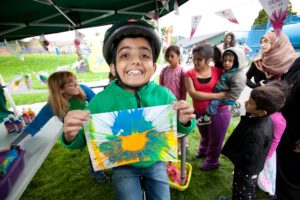Spirit's evaluator Renaisi has published a report on the learnings from Spirit's funded projects on wellbeing. Margherita Musella, Head of Reviews and Evaluation, from Works Centre for Wellbeing responds.

What have we learnt about volunteering and wellbeing from our funded programmes?

As a bridging organisation, the What Works Centre for Wellbeing aims to improve engagement between research production and practical use. The Centre has collaborated closely with Spirit of 2012 since its inception, sharing a commitment to wellbeing measurement and an understanding of what works to drive and sustain wellbeing impacts for individuals and communities
Thanks to Spirit’s test and learn approach, and a curiosity for how and why successful projects work, the fund’s evaluations have advanced the evidence base with respect to the wellbeing value of voluntary sector activities.
Renaisi’s new report commissioned by Spirit, “Understanding, supporting, and measuring wellbeing”, presents wellbeing outcomes data from 2019 and 2022. It points to the lower-than-average wellbeing of many Spirit beneficiaries at the start of each project. For nearly 40 of these projects, on average, Renaisi have found improvements in subjective wellbeing for beneficiaries post-project. Together with insights on successful delivery approaches and mechanisms of change, these findings suggest that Spirit may be driving wellbeing improvements for through its wide-ranging portfolio which addresses the key drivers of subjective wellbeing and social capital outcomes.
Wellbeing as multi-dimensional – searching for common ground
Subjective Wellbeing (SWB) is a key component of the UK’s national wellbeing framework and is measured in large-scale surveys using the ONS4 – an indicator made up of items on Life satisfaction, Sense of purpose, Anxiety and Happiness. SWB places human perspectives at the heart of conceptions of wellbeing, describing it as the feelings, experiences, and sentiments that arise from what people do and how they think. As such, SWB can be thought of as both an aspect of wellbeing as well as a proxy for a broad and multi-dimensional concept of wellbeing and its key determinants. These include good physical and mental health, strong social connections and participation in activities such as volunteering, education and learning, and good quality employment.
When used in impact evaluations, wellbeing measures provide a key source of evidence on what works to improve people’s lives and at what cost.
Spirit’s programmes embrace this multi-dimensional element by working on clear pathways to wellbeing improvements through three funding strands:
- Creative – improving participation in arts and culture;
- Connected – targeting individuals with low wellbeing and improving the quality of their relationships;
- Active – focusing on physical and mental health as key drivers of subjective wellbeing.
For the Fund, Wellbeing provides common ground across these strands, allowing for comparisons between projects with otherwise seemingly different aims and target groups. The use of the UK’s national subjective wellbeing measure – the ONS4 – tracks beneficiary wellbeing at the start and end of project journeys. It also acts as a standardised proxy measure for how individuals and communities are doing, and how they feel about their lives. The focus on beneficiary wellbeing has led some organisations to think more critically about the needs of indirect stakeholders, such as counselling services staff and volunteers, whose low wellbeing has led to the additional provision of wraparound support.
Loneliness and social connection outcomes run through several Spirit programmes, all of which aimed to improve beneficiary relationships and positively affect the way we are doing collectively as communities. Projects like the Carers Music Fund engaged female carers and used music-making to reduce social isolation, and loneliness. Changing Lives used sport and physical activity to strengthen community cohesion and broader bridging social capital outcomes. The Fund’s work builds on an established evidence base which suggests volunteering, sports, music and participatory arts practices are associated with a range of individual and community wellbeing outcomes.

Tackling low wellbeing and inequalities
The demographic breakdown of project beneficiaries from the last two years suggests the fund is targeting groups with persistently low wellbeing; 41% of programme participants reported having a disability, and over half of participants are under 25 years old. While the experience of disabled people is broad and personal, ONS data from 2021 points to the poorer rating that disabled people aged 16 to 64 years reported compared to non-disabled people on all four personal well-being measures. A higher proportion also reported feeling lonely “often or always”, over four times that of non-disabled people.
These findings can help Spirit better understand its impact on specific groups and gain unique insights to reduce inequalities, improving the way activities and services are targeted. Given the Fund’s focus on standardised wellbeing measures, such as the ONS4, there is enormous potential to generate learning on:
- How suitable general-use measures are for specific groups;
- The benefits of tested alternative evaluation tools to gather wellbeing data.
Using wellbeing measures in programme evaluations: Benefits and lessons learned
When it comes to wellbeing measurement, there is no ‘one-size-fits all’. Our Centre’s advice to funders and grantees has become increasingly tailored, as the field grows and we navigate the benefits and trade-offs of standardised wellbeing frameworks, outcomes and measures in real-life contexts.
Through our Centre’s work, we know that programme-level evaluations commissioned by funders make up an important part of the evidence base on the ONS4, mental wellbeing, and Social capital outcomes. For a Fund like Spirit of 2012, the key benefit of a global wellbeing metric like the ONS4 is its ability to capture wellbeing consistently across grant programmes and provide a definition of social value that is comparable with the national picture. When used in impact evaluations, wellbeing measures provide a key source of evidence on what works to improve people’s lives and at what cost.
However, there are external and internal factors which can limit the usefulness of these measures. As a proxy for our overall wellbeing, ONS4 scores are influenced by important external events – such as the Covid-19 pandemic and cost of living crisis – as well as changes in key areas of our lives: physical and mental health, our relationships and our work, among others. Fund-level evaluations take place in these complex and dynamic contexts, and isolating the effects of a grant programme on the wellbeing of beneficiaries can quickly become challenging. In some cases, internal or organisational factors will play a larger role, for example, the capacity of grantees to collect useable data may be limited, resulting in small sample sizes or biased wellbeing findings. Finally, for beneficiaries at risk of low wellbeing, such as people living with a disability or long-standing health issue, a more tailored measure may be required, as the average change in ONS4 baseline and endline scores at the end of a programme may not tell us very much about the effects of our activities on specific groups.
Our advice to funders is to adopt a multi-faceted approach to evaluation, ensuring that standardised measures are used carefully and their limitations are taken into account. Where possible, qualitative and creative evaluation techniques may offer a better solution, providing they are used appropriately to answer clear evaluation questions, for example, to investigate wellbeing pathways and mechanisms of change, or to make validated survey questions easier to implement in particular contexts. For all funders, a Theory of Change is fundamental to understand wellbeing outcomes at the heart of funding aims, and to map the pathways to generate sustainable improvements for individuals and communities.
Further Information
Renaisi report – Understanding, supporting, and measuring wellbeing
